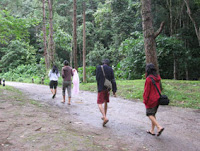
Thailand is a perfect place you’re interested in agricultural study. Food is never far from the Thai mind, because its mean much more than just holding body and soul together. If you visit the
Thai Rice Farmers Museum at Suphan Buri you will see not only the implements involved, but the many rites surrounding it and the role of the King in rice farming through history.
Each province in the central region has its own distinctive agricultural hallmark, bold enough to identify its people by. Working west to east across the top of the Gulf of Thailand, here are some of this region’s amazing riches.
Samut Songkhram’s fertile soil produces the country’s most mouth watering fruit, succulent lynches and bittersweet pomelos inparticular. Coconut groves along the coast produce not only the oily nuts themselves, but warm brown palm sugar as well. If you visit in the morning, you can see it being made.
Samut Sakhon is best known for its fresh fish markets and rasping sea-salt, but Nakhon Chaisri inland is synonymous with the juiciest, sweetest, freshest oranges in the land. If you then go east to Ongkarak district of Nakhon Nayok, you will find yourself in the midst of masses of ornamental flowers. Some of these commercial gardens, who supply Bangkok, welcome visitors.
Rayong is known countrywide as home to the spiny, green football-sized fruit adored by many and abhorred (because of its astonishing aroma!) by a few-the durain. But don’t forget to visit
Sopha Botanical Garden’s gorgeous flowering trees nearby
Khao Chamao-Khao Wong National Park also abounds with many colourful plants.
At the end of the trail,
Prachin Buri, even richer and wetter than Samut SongKhram, grows juicy citrus, durian, longan, pomelo and gorgeous soft mangosteen. Pick these up at the local market for much less than Bangkok prices.

 attention enthusiastically, opening itself further by developing a sophisticated tourism industry. Travel in the kingdom is easy, safe and cheap, and Thailand boasts a vast range of accommodation to meet the demands of young international tourists.
Attractive, well-priced and convenient, this makes a visit to the kingdom even more relaxing and rewarding. Thailand’s traveler-friendly sentiment is even more prevalent today. Tourism, particularly youth tourism, is on the increase, and Thailand is positively encouraging it in the 21st century, hoping to welcome more young visitors than ever before.
attention enthusiastically, opening itself further by developing a sophisticated tourism industry. Travel in the kingdom is easy, safe and cheap, and Thailand boasts a vast range of accommodation to meet the demands of young international tourists.
Attractive, well-priced and convenient, this makes a visit to the kingdom even more relaxing and rewarding. Thailand’s traveler-friendly sentiment is even more prevalent today. Tourism, particularly youth tourism, is on the increase, and Thailand is positively encouraging it in the 21st century, hoping to welcome more young visitors than ever before. 












 The West’s concrete jungle now threatens the world, but if you want to see the real thing, genuine primary forest that has never been disturbed except by you, it is only two to three hours drive from Bangkok.
Go west to Kaeng Krachan National Park, the country’s largest pristine forest that offers superb walking trails to study nature. Be prepared from some truly awe inspiring trees, 70 metres tall and more. Where the forest is open, it is like being inside a cathedral.
Most of the trails cluster around the single 36-kilometre road inside the park, but serious jungle treks of up to two weeks through rugged terrain can also be organized. Perhaps the best trip is to the 18-tier Tho Thip Waterfall, a full day’s outing with about three hours walking each way.
The West’s concrete jungle now threatens the world, but if you want to see the real thing, genuine primary forest that has never been disturbed except by you, it is only two to three hours drive from Bangkok.
Go west to Kaeng Krachan National Park, the country’s largest pristine forest that offers superb walking trails to study nature. Be prepared from some truly awe inspiring trees, 70 metres tall and more. Where the forest is open, it is like being inside a cathedral.
Most of the trails cluster around the single 36-kilometre road inside the park, but serious jungle treks of up to two weeks through rugged terrain can also be organized. Perhaps the best trip is to the 18-tier Tho Thip Waterfall, a full day’s outing with about three hours walking each way. 







